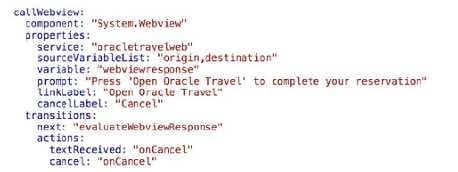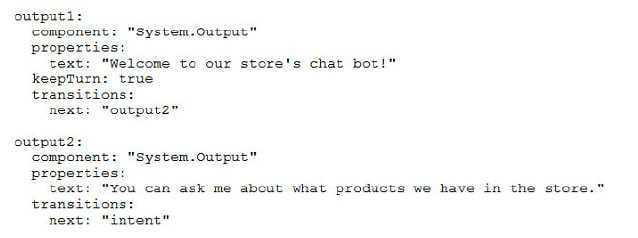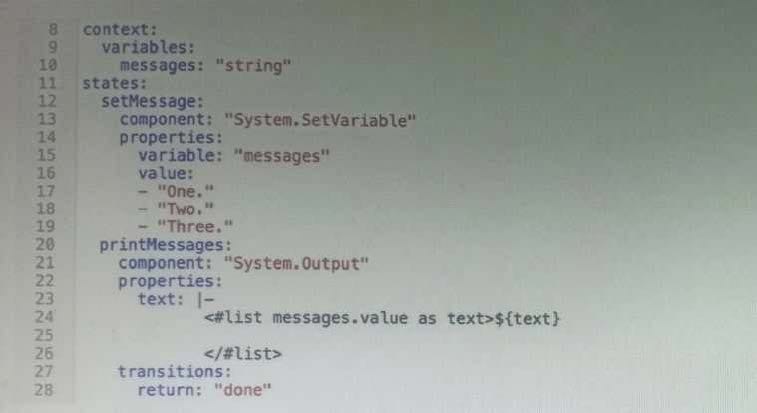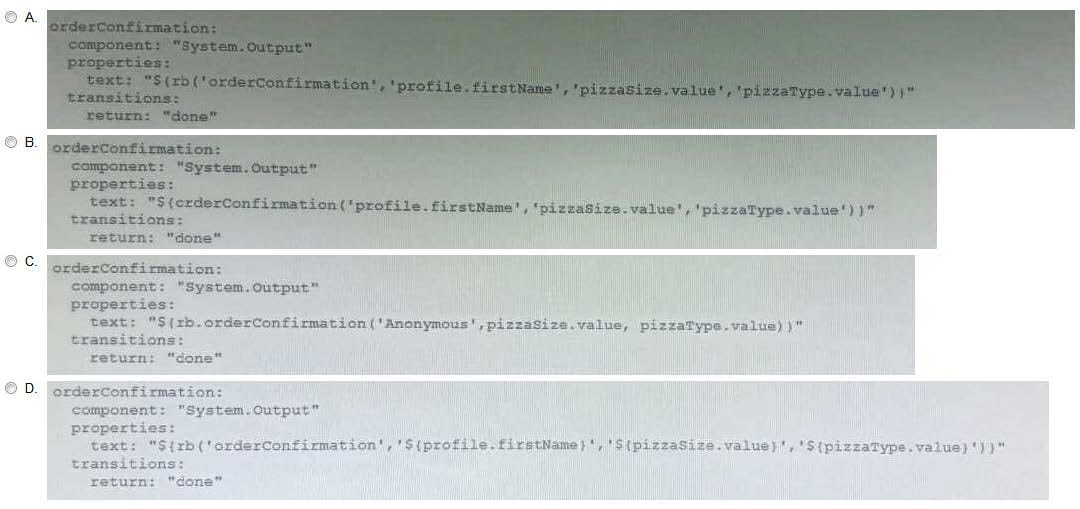1Z0-1071-20 Online Practice Questions and Answers
What happens if there is a system error and the state does not have an error action?
A. The skill transitions to the state that is defined by the defaultTransitions error action. If there isn't one, then it outputs the Unexpected Error Prompt value.
B. The skill transitions to the state that is defined by the next action. If there isn't one, then it transition to the defaultTransitions error action.
C. The skill transitions to the state that is defined by the next action.. If there isn't one, then it transitions to the next state in the dialog flow.
D. The skill outputs the Unexpected Error Prompt value and then transitions to the state that is defined by the defaultTransitions error action. If there isn't one, then it ends the conversation.
Which two statements are true regarding local web application invocation using the system.webview component?
A. Local webviews require a Node.js environment and must have a package, json file in their root folder.
B. An SPA application can issue an Ajax post command to the callback URL that has been passed with the web application launch
C. system.webview components can only be used with web channels.
D. Local webviews require SPA applications to have an index.html file in their root folder.
To prepare the remote application launch, the System, Webview component calls an intermediary service that prepare the remote web application call. The code snippet is given below:

At run time, the system.Webview component sends the intermediary service a POST request. Which three options are true for the POST payload generated based on the code?
A. Bot designer is responsible to manually add the webview.onDone parameter to the payload.
B. The key names match the name of the dialog flow variables configured in the "sourceVariableList" property of the system.webview component.
C. The webview.onDone parameter is automatically added to the payload and it passes the skill's callback URL property to the web application.
D. The POST payload is a JSON object that contains an array of key-value pairs.
E. There is no such webview.onDone property passed to the payload.
Which statement about digital assistants is FALSE?
A. A digital assistant can be used to manage a set of skills, including skills that you create yourself and skills that you have added from the Skill
B. A digital assistant ensures that a user completes a conversation in one skill before allowing that user to trigger the intent of a different skill
C. A digital assistant can communicate with customers through different messaging platforms.
D. A connection to a back-end service is through a custom component that is used by a skill, rather than one that is used by a digital assistant.
want to save some user input, such as the type of pizza a particular user last ordered, so that it's available the next time that user starts a conversation. Which type of variable should you use to persist values across multiple invocations of the conversation?
A. skill variables
B. user variables
C. context variables
D. profile variables
Which two features of Oracle Digital Assistant should you use to allow a skill to specifically classify the user message "What's my balance in savings?" and to identify the type of account?
A. an entity that defines account types (with values such as "checking" or "savings")
B. an intent that is been trained with utterances such as "check balance", "What is my current balance?", and "How much money do I have?"
C. an input form rendered by a webview that is hosted within a Digital Assistant
D. dialog flows with a system.Text component to read the user input
E. a resource bundle populated with phrases such as "check balance", "What is my current balance?", and "How much money do I have?"
What happens after the skill output Welcome to our store's chat bot!'' in this dialog flow?

A. The skill displays "Welcome to our store's chat bot!" again.
B. The skill goes to output2, outputs "You can ask me about what products we have in the store", and then returns control to the user.
C. The skill returns control to the user. After the user enters text, it goes to the intent state.
D. The skill returns control to the user. After the user enters text, it goes to output2 and outputs "You can ask me about what products we have in the store."
You are designing a skill for a railway company. You created a value list entity (StationEntity), which is the list of all possible train stations To resolve an intent (Routelnfolntent), you need to determine whether the user is asking for a route which is either to a station or from a station. Which statement describes the most robust and efficient approach for extracting this information from the user input?
A. Create a value list entity called ToFromEntlty with values of "to" and "from" and with appropriate synonyms for each value. Create a value list called DirectionStation and add ToFromEntity and StationEntity to this. Then, add DirectionStation to the Routelnfolntent.
B. Create two derived entities based on StationEntity. In one entity, set the preceding phrase to "to" (along with any required synonyms). In the other entity, do the same but with the preceding phrase "from". Add both entities to the Routelnfolntent intent.
C. Duplicate StationEntity. In one version, prefix all of the train station names with "to" and in the other prefix with "from". Then add both entities to the Routelnfolntent intent.
D. Add StationEntity to the Routelnfolntent intent and then update the training data with phrases beginning with "from".
The agentActions property in the System.AgentInitiation component:
A. Defines the states to which agents can optionally transfer a user when the agent ends the chat.
B. Sets the message to be displayed when an agent is first connected to a chat session.
C. Sets the message to be displayed if an agent refuses a chat request.
D. Sets the agent's post-chat configuration (for example, "ready", "wrap", and so on).
You are writing a dialog flow and you are at the end of the conversation. For the final state, you are not sure whether to use a return transition or use a next transition that goes to the start of the dialog flow. Which statement is true?
A. The next and return transitions are the same and you can use them interchangeably.
B. The return transition goes to the start of the dialog flow and resets all variables, whereas next simply navigates.
C. The next transition automatically clears variables on navigation, whereas return doesn't.
D. The next transition can only be used for forward navigation in the flow.
Which three statements are FALSE regarding entity resolution using a composite bag?
A. You can define multiple prompts for each entity item in the composite bag.
B. The composite bag will automatically resolve any entity values found in the initial user input.
C. When a user inputs entity values, they can only be resolved in the order in which they are defined within the composite bag.
D. Each entity item in the composite bag can have only one value.
E. Every entity item in the composite bag must be prompted for and have a value entered.
F. You can define validation code using Apache Freemarker for entity item values.
Select the FALSE statement regarding confidence levels when routing within a digital assistant.
A. A confidence threshold is a value that's compared to the confidence level by the system, intent component to define the next action.
B. Confidence level is the intent engine's score for utterance classification.
C. All skills within a digital assistant must have the same confidence threshold.
D. If other intents that exceed the confidence threshold have scores that are within that of the top intent by less than the win margin, these intents are also presented to the user.
What is the output of this code?

A. The code will run into an infinite loop.
B. Only first value - "One" will be printed.
C. The code will fail to validate because |- is not a valid symbol.
D. All the three values - "One." "Two." and "Three." will be printed.
Which is a FALSE statement about empty transitions?
A. Empty transitions can lead to unexpected navigation.
B. You should define a next transition on every state.
C. Empty transitions occur when using the next transition element.
D. Avoiding empty transitions will prevent many unexpected dialog flows.
To translate output messages, you created a resource bundle in your skill. The resource bundle contains an orderConfirmation key with the following message: Thanks {0} for your order. Your order of a {1} is no its way. In your dialog flow, you have a variable rb of type resourcesBundle defined. In additional, you defined a variable pizzaType holding the type of the pizza (for example, Salami) and a variable pizzaSize holding the size of the Pizza ( for example , large).

A. Option A
B. Option B
C. Option C
D. Option D
